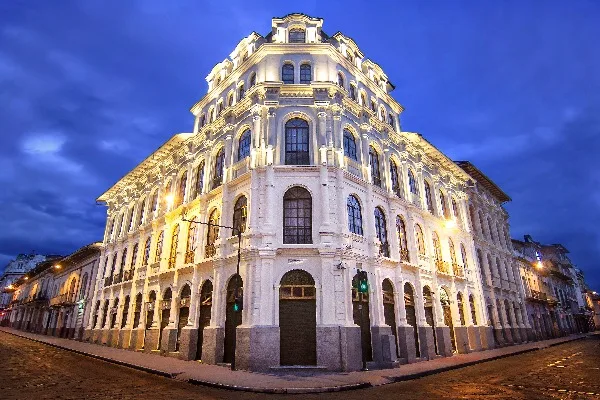They’re noisy and smokey but Cuenca’s buses get you where you need to go
By Deke Castleman
Among the first sights noticed by newcomers to Cuenca, along with the billowing white clouds, the rolling green hills, and the red-tile roofs, are the big blue and red buses that spew black fumes into the otherwise colorless alpine air.

Buses entering El Centrofrom El Vado.
Hundreds of them bomb around town, from roughly 5:45 a.m. till 10 p.m. on weekdays, and 6 a.m. to 7 p.m. weekends, servicing more than two dozen lines operated by seven different bus companies.
There’s no doubt about it. These buses are fumy, issuing diesel exhaust every time they accelerate in first and second gear roughly once every block or two.
It’s loud inside the bus, outside the bus, and inside residences that line the bus routes.
The seats are decidedly gringo-unfriendly, especially if you’re tall (like me) or saddled with a skinny butt (like mine). That’s if a seat is available and you aren’t squished among other standing-room-only passengers, such as commuters, students, mothers of children from two weeks to 12 years old, teenagers making the rounds, vendors with big baskets full of produce or chifles or market wares, even barkers standing at the head of the aisle addressing the whole bus, selling something.
Most buses are Mercedes vehicles that, new or old, bounce around on the cobblestones and pavement without the benefit of shock absorbers. The drivers shift gears with varying degrees of jerkiness, and they seem to accelerate till the very last moment, then brake hard, so you feel like you’re climbing uphill as you make your way to the back of the bus to disembark at your stop. It’s fun to hang out the back door, which the driver often opens at 25 mph a half-block or so from the bus stops.
Yet, even in the face of all that, the buses of Cuenca are one of the best things about it; you almost couldn’t ask for a better mass-transportation system.
The buses are frequent, convenient, and inexpensive. They run to within a few blocks of anywhere you need to go; they also touch all corners of the suburbs and exurbs, from Challuabamba to Narancay, from Racar to El Valle, from San Joaquin to Ricaurte, from Sayausí to Capulispamba. In terms of security, they’re are safe for passengers (though as anywhere in the world, be aware of your belongings and surroundings).
You determine the buses’ route numbers, ultimate destinations, and main stops along the way by the signs in the lower left corner of their front windshields.
Bus guides (the Guía de la Ciudad y TransporteUrbano) have been intermittently available since October 2010; if they’re in stock, you can pick one up at iTur, the tourist office opposite Parque Calderón. Before the guides appeared, the buses were pretty much the dominion of Cuencanos, because they were the only ones who knew where they went! Since the guides came out, anyone with the ability to read a map can ride them with confidence.
Big blue bus-stop signs (Parada de Bus) line all the busy streets; the closer you are to El Centro, the more sign-posted bus stops there are. Where there aren’t any signs, you flag down the bus and it picks you up wherever you happen to be. (You don’t put your palm up in the common American “stop” gesture; instead, your palm faces the ground and you sort of make a “slow-down” motion to signal the driver.) You enter the bus through the front door.
The fare is 25 cents. You can go anywhere the buses go by dropping a quarter into the slot on the coin acceptor. If there are two of you, most slots accept 50-cent pieces as well (show it to the driver, so he knows you’re paying for two). The fare ostensibly requires exact change, but in a pinch, the drivers will either make change or orchestrate the process with incoming passengers, where you give the driver, say, a fifty-cent piece and he instructs the next passenger with a quarter to give it to you as change.
You can also buy a tarjeta de bus (bus pass) at numerous tiendas around the city; look for the signs that say “Urbano.” The card itself costs $1.70 and you load it up with saldo (credit), say $10 for 40 rides. The card is scanned by an electronic reader at the front of the bus that responds with, “Gracias,” which sounds like something between a sneeze and an early-morning rooster; it also shows you how much saldo remains on your card.
Always exit out the back. Just press the red button on the post by the
back door; that signals the driver to open the door. If the bus is still
moving when it’s time to hop off, just step toward the back wheels, so
the vehicles forward momentum and your backward direction will offset
each other and you’ll hit the ground straight up.
Until now, there’s been no such thing as a transfer but that’s about to change. Two new bus transfer stations, one at Terminal Terrestre, Cuenca’s long-distance bus terminal on Av. España, and anther on Av. Las Americas just south of the Feria Libre market are about to open and passengers will be able to transfer at no additional cost, to other buses.
Major change are is in the wind for the city bus system and they will have a big impact on the historic district. In October or November, the new transfer stations will mean that fewer buses will circulate in El Centro. In early 2015, Cuenca’s new light rail system, Tranvia de los Cuatro Rios, will go operational and since it will pass through the district on Calles Gran Colombia and Sangurima, more bus routes will be eliminated. Among other things, the changes should mean cleaner El Centro air.
Long distance buses
The Terminal Terrestre, located on Av. España halfway between the redondel at Huayna Capac and the airport.
This is as well-organized and non-threatening a terminal as you’ll find in Ecuador, with buses leaving frequently for all points north, south, west, and east.
For example, Santa, claiming to be in business since 1945, runs buses to Quito, starting at 3:20 a.m., stopping in Riobamba, Ambato, and Latacunga. Pullman Sucre does the Ecuador-Peru route, departing at 5:15 a.m. to Tumbes, 7:15 to Huaquillas and Tumbes, 9 to Auchillas andMancora, and 10:45 to Tocambio and Tumbes. Ejecutivo San Luis buses head down to Guayaquil through El Cajas once an hour. These bus companies, which service long-distance destinations, are located on the east side of the terminal.
On the terminal’s west side are the bus companies that service closer destinations and leave more frequently. Buses to Cajas, Gualaceo, Paute, Azogues, and other nearby towns leave approximately every 15 minutes; you can buy tickets at one of nearly 25 windows.
You have to pay ten cents to go through the turnstyle to get to the salidas al buses, or the bus departure gates. You put a dime into the slot, which releases the gate. If you don’t have a dime, a guy sits in front of the turnstyle and makes change. There’s also a coin-changing machine nearby, the only one I’ve ever seen in Cuenca; you insert a dollar bill and out drop ten dimes.
Lots of shops at Terminal Terrestre sell sundries, perfume, DVDs, produce, and dry goods. Here, too, are several fast-food counters serving comida típico: secos, chaulafan, guatitas, encebollado, and more, all in the $1.50-$2 range. Luggage handlers, taxi drivers, and shoeshiners congregate outside; make sure you agree on a price for their services before engaging them (especially for a shoe shine). There’s also an iTur office at Terminal Terrestre, where you can pick up brochures and flyers and even a stray coupon or two for traveler amenities in Cuenca.
And, of course, numerous big blue city buses stop here too, just outside the terminal on Avenida España, then depart on routes throughout Cuenca and beyond.



















